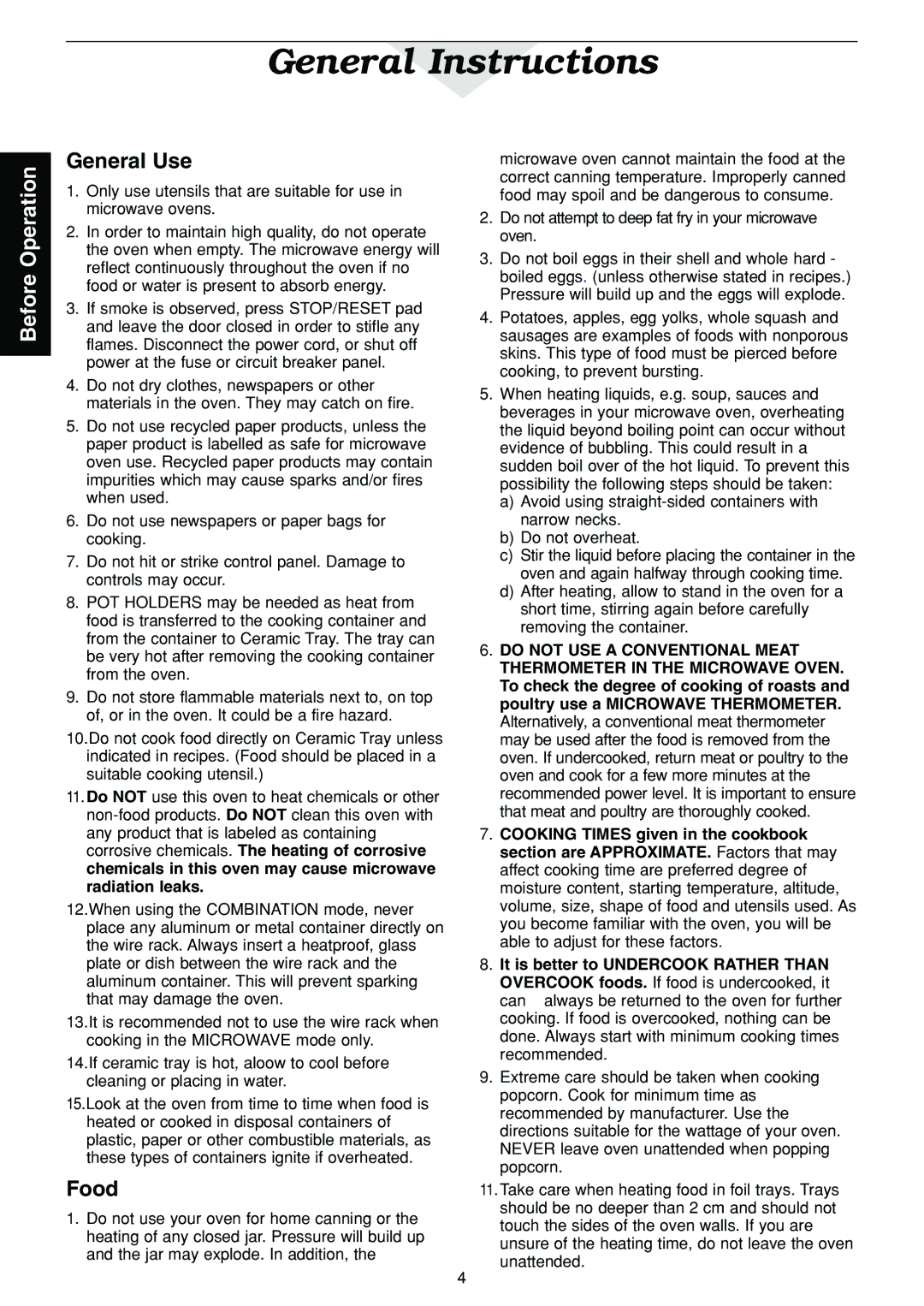
General Instructions
Before Operation
General Use
1.Only use utensils that are suitable for use in microwave ovens.
2.In order to maintain high quality, do not operate the oven when empty. The microwave energy will reflect continuously throughout the oven if no food or water is present to absorb energy.
3.If smoke is observed, press STOP/RESET pad and leave the door closed in order to stifle any flames. Disconnect the power cord, or shut off power at the fuse or circuit breaker panel.
4.Do not dry clothes, newspapers or other materials in the oven. They may catch on fire.
5.Do not use recycled paper products, unless the paper product is labelled as safe for microwave oven use. Recycled paper products may contain impurities which may cause sparks and/or fires when used.
6.Do not use newspapers or paper bags for cooking.
7.Do not hit or strike control panel. Damage to controls may occur.
8.POT HOLDERS may be needed as heat from food is transferred to the cooking container and from the container to Ceramic Tray. The tray can be very hot after removing the cooking container from the oven.
9.Do not store flammable materials next to, on top of, or in the oven. It could be a fire hazard.
10.Do not cook food directly on Ceramic Tray unless indicated in recipes. (Food should be placed in a suitable cooking utensil.)
11.Do NOT use this oven to heat chemicals or other
12.When using the COMBINATION mode, never place any aluminum or metal container directly on the wire rack. Always insert a heatproof, glass plate or dish between the wire rack and the aluminum container. This will prevent sparking that may damage the oven.
13.It is recommended not to use the wire rack when cooking in the MICROWAVE mode only.
14.If ceramic tray is hot, aloow to cool before cleaning or placing in water.
15.Look at the oven from time to time when food is heated or cooked in disposal containers of plastic, paper or other combustible materials, as these types of containers ignite if overheated.
Food
1.Do not use your oven for home canning or the heating of any closed jar. Pressure will build up and the jar may explode. In addition, the
microwave oven cannot maintain the food at the correct canning temperature. Improperly canned food may spoil and be dangerous to consume.
2.Do not attempt to deep fat fry in your microwave oven.
3.Do not boil eggs in their shell and whole hard - boiled eggs. (unless otherwise stated in recipes.) Pressure will build up and the eggs will explode.
4.Potatoes, apples, egg yolks, whole squash and sausages are examples of foods with nonporous skins. This type of food must be pierced before cooking, to prevent bursting.
5.When heating liquids, e.g. soup, sauces and beverages in your microwave oven, overheating the liquid beyond boiling point can occur without evidence of bubbling. This could result in a sudden boil over of the hot liquid. To prevent this possibility the following steps should be taken:
a)Avoid using
b)Do not overheat.
c)Stir the liquid before placing the container in the oven and again halfway through cooking time.
d)After heating, allow to stand in the oven for a short time, stirring again before carefully removing the container.
6.DO NOT USE A CONVENTIONAL MEAT THERMOMETER IN THE MICROWAVE OVEN. To check the degree of cooking of roasts and poultry use a MICROWAVE THERMOMETER. Alternatively, a conventional meat thermometer may be used after the food is removed from the oven. If undercooked, return meat or poultry to the oven and cook for a few more minutes at the recommended power level. It is important to ensure that meat and poultry are thoroughly cooked.
7.COOKING TIMES given in the cookbook section are APPROXIMATE. Factors that may affect cooking time are preferred degree of moisture content, starting temperature, altitude, volume, size, shape of food and utensils used. As you become familiar with the oven, you will be able to adjust for these factors.
8.It is better to UNDERCOOK RATHER THAN OVERCOOK foods. If food is undercooked, it
can always be returned to the oven for further cooking. If food is overcooked, nothing can be done. Always start with minimum cooking times recommended.
9.Extreme care should be taken when cooking popcorn. Cook for minimum time as recommended by manufacturer. Use the directions suitable for the wattage of your oven. NEVER leave oven unattended when popping popcorn.
11.Take care when heating food in foil trays. Trays should be no deeper than 2 cm and should not touch the sides of the oven walls. If you are unsure of the heating time, do not leave the oven unattended.
4
